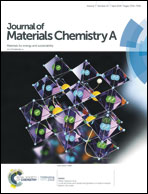Metal–organic framework composites and their electrochemical applications
Abstract
Metal–organic frameworks (MOFs) are a new class of porous coordination polymers, which are distinguished among polymer materials due to their remarkable properties, such as large surface area, adjustable structure and high porosity, and therefore, have generated extensive interest. Nevertheless, the poor electrical conductivity and narrow micropores of MOFs have constrained their applications. Hence, MOF composites, in which MOFs are combined with a variety of functional materials, have been introduced to mitigate the disadvantages of individual components. Zero-dimensional materials such as nanoparticles and quantum dots, one-dimensional materials (nanorods, nanotubes and nanobelts), and two-dimensional nanosheet materials can be combined with MOFs, and three-dimensional MOF composites have also been reported, including core–shell and cubic composites. In this review, the recent development of MOF composites and their synthetic methods, and their electrochemical applications, including catalysts, sensors, supercapacitors and batteries, are discussed according to their dimensions.

- This article is part of the themed collection: Recent Review Articles


 Please wait while we load your content...
Please wait while we load your content...